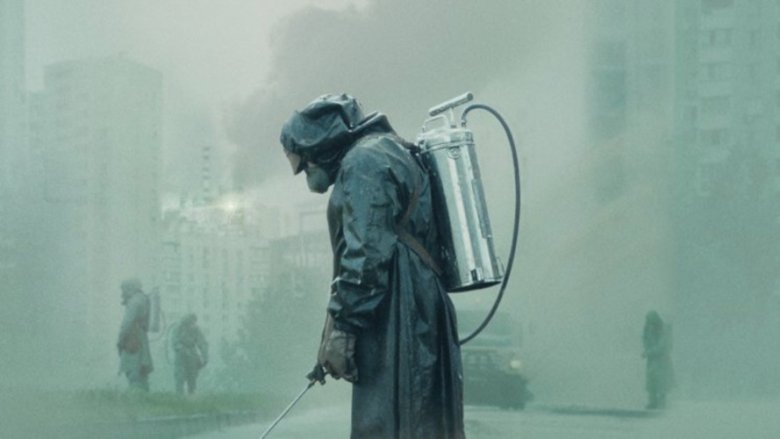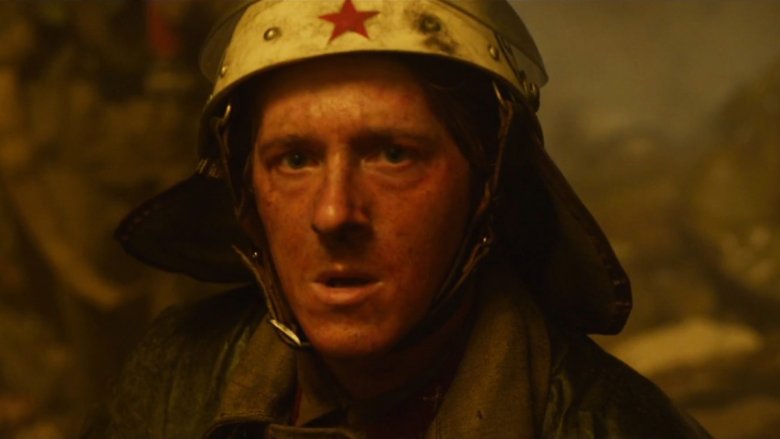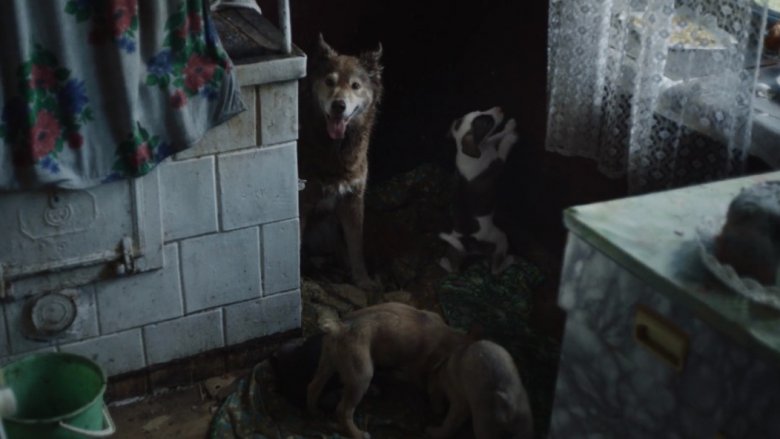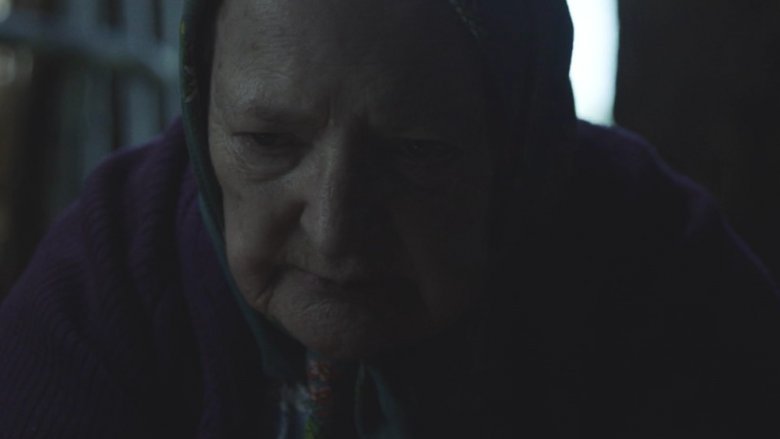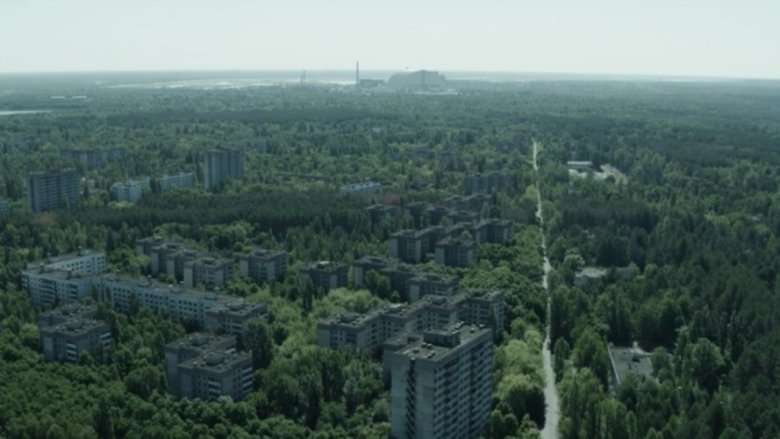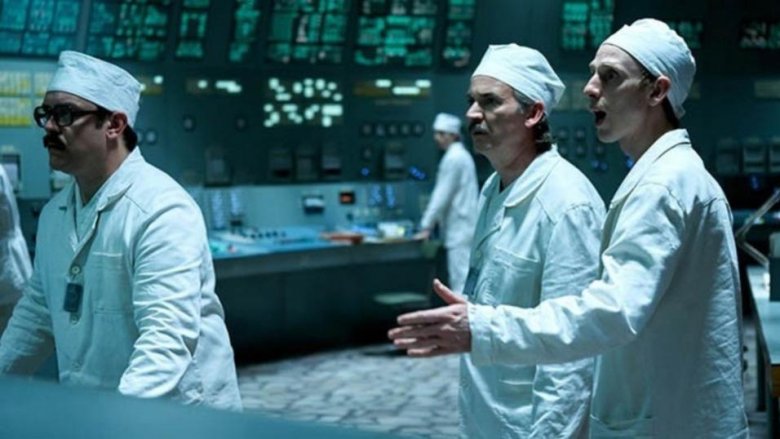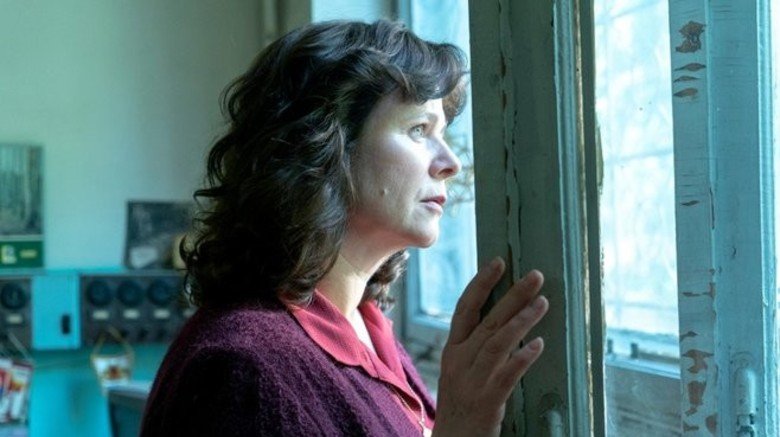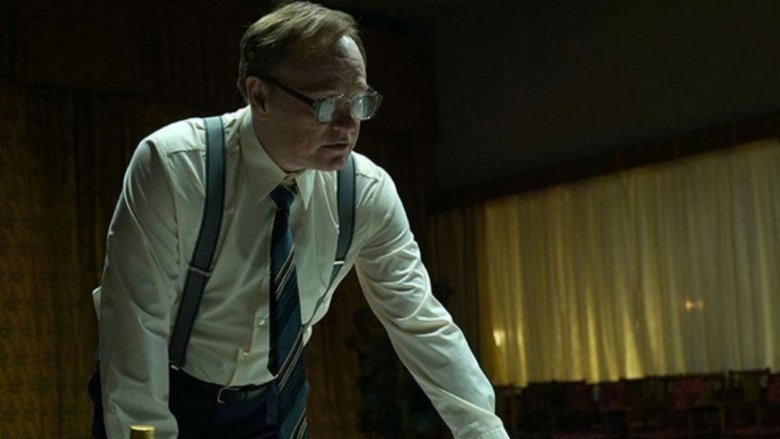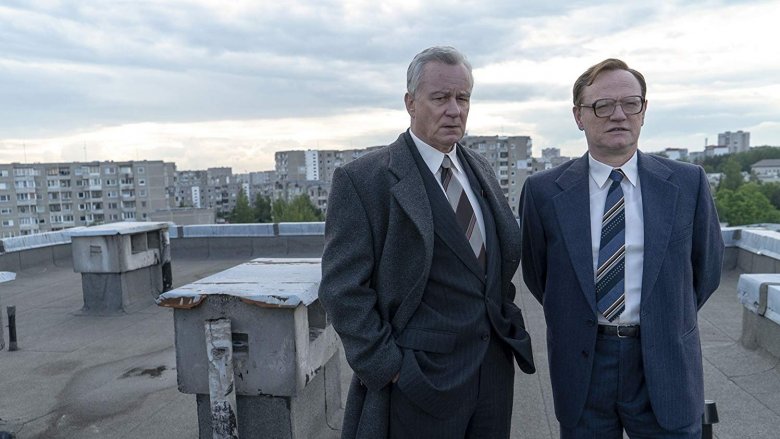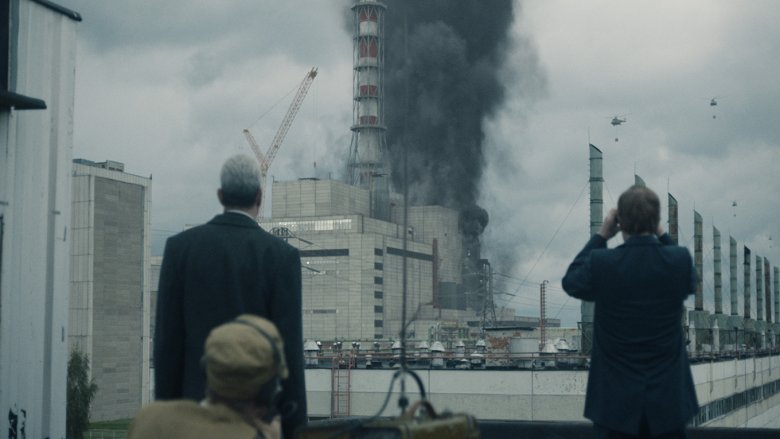The Biggest Unanswered Questions In Chernobyl
HBO's chilling mini-series Chernobyl chronicles the 1986 nuclear reactor disaster that could have rendered a huge chunk of the then-Soviet Union a ghost town. At the time, the event was cloaked by the characteristic secrecy of the USSR. Now, a little over three decades after the tragic events and not quite thirty years since the dissolution of the Soviet Union, we know more about the series of events leading up to the disaster, the damage it caused, and how it cut short far too many lives.
But as Chernobyl (and even the briefest research into the event) reveals, we still don't know enough. If it weren't for the efforts of Valery Legasov (played by Jared Harris in the mini-series) and others like him, we wouldn't even know as much as we do. Chernobyl shows us not only the science behind the accident and its horrific cost, but the immovable Soviet bureaucracy that stood in the path of not only immediate life-saving efforts but overall recovery because it valued secrecy more than reason. As a result, it's difficult to finish watching Chernobyl without some unanswered questions.
Here are the biggest of the many unanswered questions we're left with after the finale of HBO's Chernobyl.
The death toll
A lot of numbers get thrown around in Chernobyl. We get catastrophic figures when Legasov explains the worst case scenario to the Soviet Central Committee. Because of the efforts of the divers, the Tula miners, and others, the worst is narrowly avoided. When Legasov gives the numbers needed to contain the disaster — the materials, the workforce, the cost, the years, and the lives — it sounds like horrific science fiction.
Ironically, in spite of all these numbers that bounce around HBO's Chernobyl, there's no concrete death toll figure. Part of the problem is the Soviet Union's lack of records, but another, trickier issue is the way radiation exposure complicates things. As the Express points out, along with the people who died in the disaster's immediate aftermath there were those who — as the series portrays with both Legasov and Boris Shcherbian (Stellan Skarsgård) — took years for their illnesses to become life-threatening. Notes at the end of the series finale put the death toll between 4,000 and 93,000, but those numbers are far from universally accepted. Express reports the Union of Concerned Scientists estimates between 4,000 and 27,000 lives lost, while Greenpeace believes it to be in the range of 93,000 to 200,000. Chernobyl showrunner Craig Mazin tells Express he's read estimates putting it "closer to a million."
Unfortunately, as far as the question of how many people died is concerned, the only answer we can all agree on is too many.
The pets of Chernobyl
One of the most heartbreaking chapters of an already emotionally taxing story comes in the fourth episode, in which we follow a trio of Soviet liquidators tasked with killing any animals — mostly domesticated pets — left behind in abandoned villages. Fleeing civilians were not allowed to bring pets with them for fear the pets could contaminate humans. The episode was understandably so difficult for some viewers that showrunner Craig Mazin felt he needed to take to Twitter to explain what we see in the episode is a "toned down" version of what actually occurred.
In early June 2019, Business Insider South Africa reported that despite the efforts of these real life liquidators, there remains a "thriving population" of radioactive animals in the Chernobyl Exclusion Zone. They put the total at around 800 — around 600 dogs and 200 cats. Groups like the Clean Futures Fund and SPCA International visit the zone to care for the animals, carrying out the necessary spaying, neutering, and vaccination.
Earlier in 2019, for the first time, 15 puppies whose radiation levels were low enough to be considered safe were were taken from the Exclusion Zone and adopted into "forever homes" in the United States.
Did anyone refuse to leave?
Chernobyl's fourth episode opens with an elderly woman milking a cow while a Soviet soldier repeatedly demands she leave with him. Without stopping her milking, the woman recounts the history of her family — how everyone from the Bolsheviks to the Nazis had stood where the soldier is standing with guns in their hands, and that every time, her family refused to leave. Her story ends with a loud gunshot... but it's her cow, not her, who falls dead. We never learn how the confrontation resolves, but the last we see of the woman, her hands are shaking over her dead cow and we're left to wonder if this means the soldier has finally broken her spirit.
The scene may make you wonder if there were any real people who remained in the affected areas despite the Soviet military's efforts. Amazingly, there were... and even more surprisingly, they're still there.
In 2017, the Irish Times visited the so-called "samosely" — those who illegally returned to Chernobyl to live there after the disaster. Despite the predictions and warnings from scientists, the Times said around 200 people still lived there and were living well into their eighties, though they faced threats from wild animals and dwindling population. In 2016, the BBC spoke to Russian photographer Andrej Krementschouk, who had been traveling into the Chernobyl Exclusion Zone since 2008 to document the lives of the samosely... which aren't nearly as post-apocalyptic as you'd think.
When will the Exclusion Zone be safe?
By the end of the miniseries, it isn't clear exactly when it will be safe for human beings to return to and live in what is now the Chernobyl Exclusion Zone. Some say it would be a staggering 20,000 years before humans could return to the Zone. But as Newsweek points out, that number "refers specifically to the Elephant's Foot, the highly radioactive remains of the reactor itself."
Newsweek's story goes on to say that it's difficult to get a precise number because "contamination levels are not consistent in the surrounding area" and pieces of the reactor continue to leak radioactivity into the soil. The presence of the samosely further complicates things, because the fact that the 200 or so illegally settled citizens continue to live in the area convince some that there's nothing dangerous about the Zone. But as Express points out, while samosely may not be dying in some of the dramatic and grisly manners in which we see Chernobyl operators and firefighters die in the HBO series, cancer diagnoses — particularly thyroid cancer and leukemia — have spiked since the accident.
Newsweek says experts' estimates range between "20 years and several hundred years" before the Exclusion Zone is safely habitable. Considering the broad range of estimates, you might want to just forget about it and vacation somewhere else.
Fact vs. Fiction
Chernobyl doesn't pull a lot of punches, and sometimes that can make us forget that even so-called "hard hitting" drama is, in the end, drama. There are always gaps between the reality and the portrayal, and Chernobyl is no exception.
Speaking to CBS News, Midnight in Chernobyl author Adam Higginbotham praised the HBO series. The author claimed that moments like the "bio robots" scene, in which men are made to toss contaminated debris from the power plant's roof in 90-second intervals, could just as well have been based on documentary footage. He was also pleased with the apparently accurate portrayal of many of the Soviet Union's apathetic bureaucrats. However, Higginbotham did say that the scientists' surprise at the power plant's flaws was manufactured. "In reality," he said, "so many nuclear scientists knew all along that there were problems."
The New Yorker's Masha Gessen was not as forgiving. Despite being impressed with things like costume design and setting, Gessen claimed that the series' most damning crime was "its failure to accurately portray Soviet relationships of power." She pointed out that the repeated threat of having people shot — as Shcherbian threatens to have Legasov shot in the first episode — is something that went away after the 1930s. She also took issue with Legasov's apparent ignorance of the Soviet bureaucracy, writing that if he were that naive, he never would have achieved enough success to have his own lab.
The cast
While many of the characters we meet in HBO's Chernobyl did exist, there is one notable exception.
At the end of the series finale, we learn that Ulana Khomyuk — the scientist who risks arrest to bring Legasov her revelation that using boron and sand on the site of the destroyed reactor would ultimately make things worse — is a fictional character. Notes tell us that Legasov "was aided by dozens of scientists who worked tirelessly" with him. We also learn some would be imprisoned for speaking out against the Soviet Union's "official account of events." Khomyuk, the notes continue, is meant to "represent them all and to honor their dedication and service."
This is fitting, considering the inaccuracies pointed out by Adam Higginbotham and Masha Gessen. Many of their criticisms are reflected in the fictional Khomyuk. She's the head of the investigation into revelations that, according to Higginbotham, wouldn't have been revelations. And as Gessen points out about Legasov, she's just as naive and opposed to the same Soviet bureaucracy she would have, in real life, needed to work with in order to achieve any professional success.
How did the tapes get out?
Chernobyl opens two years after the disaster, with Valery Legasov recording his secrets on audio tapes. Before hanging himself, Legasov makes like he's taking out the trash to fool his KGB watchmen and uses the opportunity to drop the tapes in a nearby building. A note at the end of the series finale tells us the tapes were "circulated among the Soviet scientific community," which seems to confirm that this part of the story is accurate. However, we never learn who Legasov expects to retrieve the tapes. We don't know if he's been in contact with a journalist, or perhaps with another scientist. The obvious answer is the conscience-driven Ulana Khomyuk, but Khomyuk was a fictitious stand-in for many real people.
Speaking to CheatSheet about how he prepared for the role of Valery Legasov, Jared Harris said one of his biggest challenges was that there was little historical record left on Legasov to study because the Soviet Union "erased him from history," much as KGB Chairman Charkov (Alan Williams) promises in the series finale. When CheatSheet asked Harris why he hadn't listened to Legasov's audio tapes, Harris said the answer was simple. Contrary to what happens in the series, Harris told CheatSheet, "There were no audio tapes. He left behind journals. But that's not as cinematic as audio tapes."
While he didn't go into detail, Harris noted that even the journals were "very hard to get ahold of."
The fall of the USSR
As the Chernobyl series finale comes to a close, one of the many things we read is a 2006 quote from Mikhail Gorbachev, the Soviet Union's final leader. It reads, "The nuclear meltdown at Chernobyl... was perhaps the true cause of the collapse of the Soviet Union." Unfortunately, at least within this final episode, there's no clarification on what this means.
In 2013, Mark Joseph Stern wrote an article for Slate explaining what he called the "nuclear theory of the fall of the USSR." He explained that shortly before the explosion at Chernobyl, Gorbachev had already introduced glasnost, i.e. a policy of "openness of ideas and expression." Stern wrote that it was Gorbachev's way of combating "widespread censorship and government secrecy" in the Soviet Union, and glasnost is widely credited for the USSR's eventual dissolution in 1991. The aftermath of the Chernobyl accident, Stern and Gorbachev argue, is what wound up fueling glasnost.
Stern wrote that before Chernobyl, most Soviet citizens "believed in the Soviet system, forgave its flaws, and hoped for a better future." But the reactor explosion and everything that came to light afterwards put questions in the minds of citizens — crucial questions about what was in their food and water. That new distrust for the Soviet State, according to the nuclear theory, fueled glasnost in a way that made the USSR's demise inevitable.
Could it happen to us?
The horrible aftermath of Chernobyl as depicted in HBO's mini-series probably has plenty of viewers wondering if what happened in 1986 in Ukraine could happen in the United States. In 2016, Business Insider talked to Andrew Leatherbarrow, who was promoting his nonfiction book Chernobyl 01:23:40. The writer/photographer explained why what happened at Chernobyl couldn't happen in the States.
The key, Leatherbarrow says, is the graphite. If you've seen the series, then you know the power plant's graphite-tipped control rods are what caused the reactor explosion. The writer called the use of graphite "an incredibly foolish decision." While the point of the control rods is to "slow down a nuclear reaction," graphite does exactly the opposite.
Thankfully, Business Insider notes, American reactors use water instead of graphite. "There's absolutely no way the accident at Chernobyl could have happened at any American commercial power reactor," Leatherbarrow explained.
But before you breathe easier, this doesn't mean a meltdown can't happen at a nuclear power plant in the U.S. Americans learned a meltdown at one of their plants was possible in 1979's Three Mile Island incident, just as the Japanese learned in 2011 with the Fukushima meltdown. It's simply that the specific kind of event that triggered the Chernobyl accident couldn't happen here.
